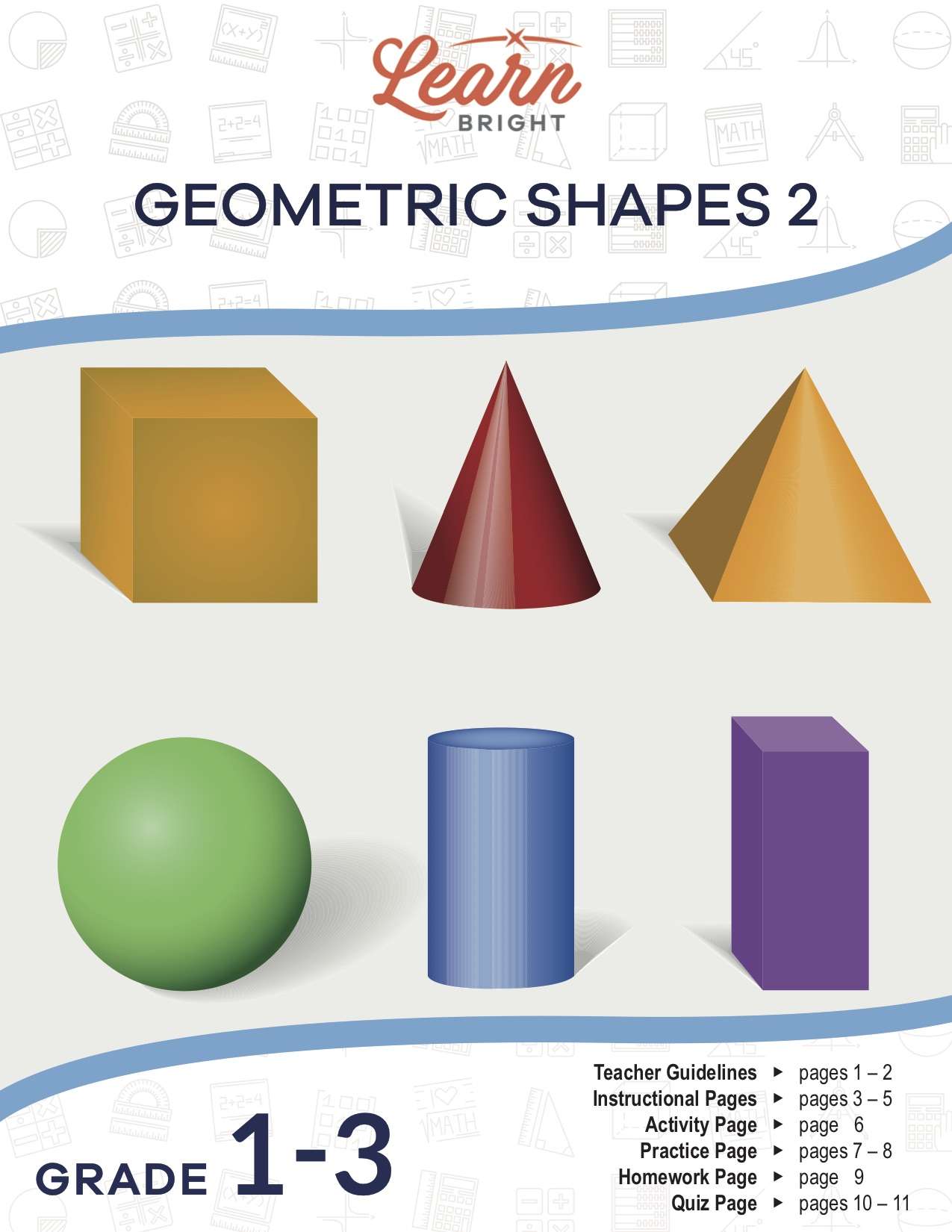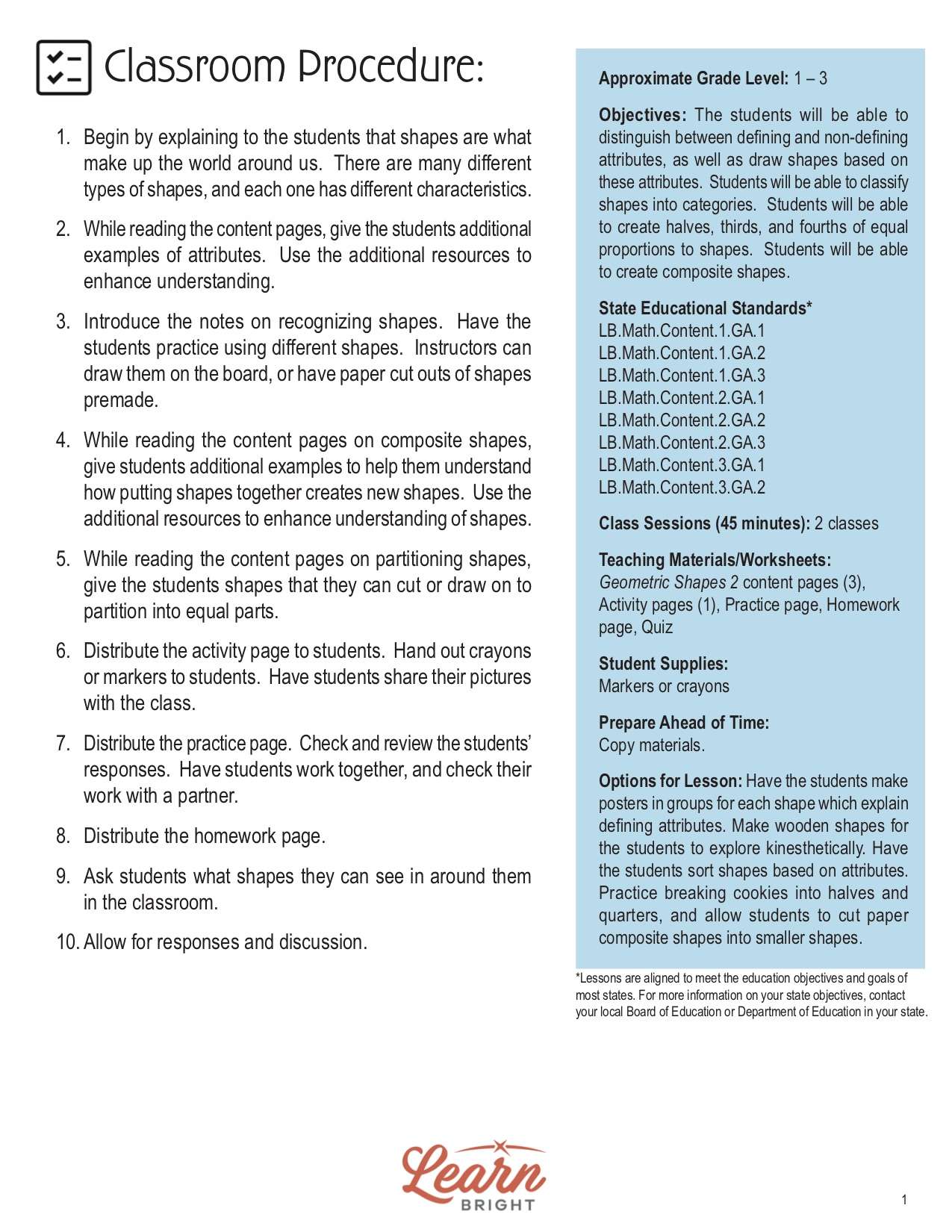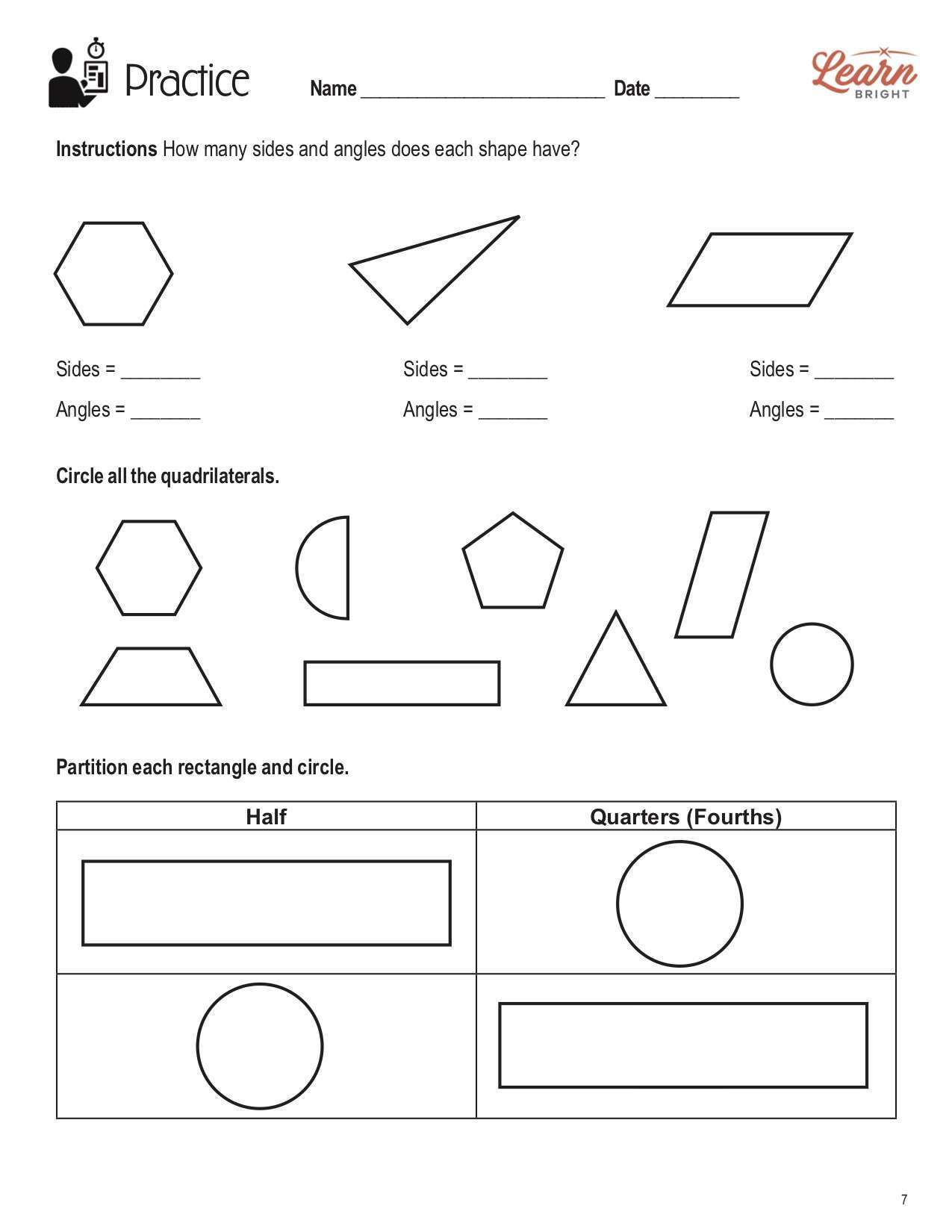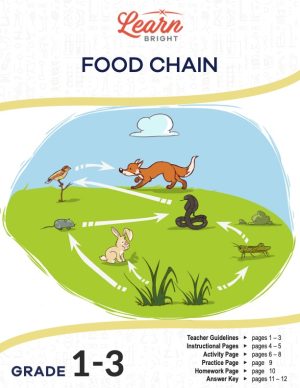Description
What our Geometry Shapes 2 lesson plan includes
Lesson Objectives and Overview: Geometry Shapes 2 teaches students about defining and non-defining attributes of many shapes. Students will learn how to identify and draw shapes based on these traits. They will also learn how to divide shapes into even portions. By the end of the lesson, they will also be able to create composite shapes. This lesson is for students in 1st grade, 2nd grade, and 3rd grade.
Classroom Procedure
Every lesson plan provides you with a classroom procedure page that outlines a step-by-step guide to follow. You do not have to follow the guide exactly. The guide helps you organize the lesson and details when to hand out worksheets. It also lists information in the blue box that you might find useful. You will find the lesson objectives, state standards, and number of class sessions the lesson should take to complete in this area. In addition, it describes the supplies you will need as well as what and how you need to prepare beforehand.
Options for Lesson
Included with this lesson is an “Options for Lesson” section that lists a number of suggestions for activities to add to the lesson or substitutions for the ones already in the lesson. One optional addition to this lesson is to have your students make posters in groups for each shape which explain defining attributes. You could also make wooden shapes for the students to explore kinesthetically, and have them sort the shapes based on attributes. You could also have your students practice breaking cookies into halves and quarters, and allow students to cut paper composite shapes into smaller shapes.
Teacher Notes
The teacher notes page includes lines that you can use to add your own notes as you’re preparing for this lesson.
GEOMETRY SHAPES 2 LESSON PLAN CONTENT PAGES
Defining and Non-Defining Attributes
The Geometry Shapes 2 lesson plan includes three content pages. Attributes are characteristics that describe an object. In math, attributes often fall within a pattern. We have two types of attributes in math: defining and non-defining. Defining attributes tell, or determine, what the shape is.
A circle’s defining attributes are that they’re round and all points are equidistant from the center. A square’s defining attributes are that they have four equal sides and four 90 degree angles. For rectangles, their defining attributes are two sets of parallel lines and four 90 degree angles. Finally, a triangle’s defining attributes are that their three sides do not need to be equal and that they have a closed figure.
Non-defining attributes don’t define the kind of shape, but rather describe the shape. Some non-defining attributes include color, orientation, and size.
Recognizing Shapes
We create two-dimensional shapes using angles and sides. To recognize shapes, we need to understand their attributes. Triangles have three sides and three angles. Quadrilaterals have four sides and four angles. Pentagons have five sides and five angles. Hexagons have six sides and six angles.
Mathematicians use these attributes to classify shapes into different groups. For example, all closed figures with three sides are triangles and all closed figures with four sides are quadrilaterals. There are many different types of four-sided figures, so it’s important to pay attention! Quadrilaterals, in addition to being a closed figure with four sides, are classified by their parallel lines, the degree of their angles, and the length of their sides.
Parallelograms, for example, are quadrilaterals with opposite sides that are parallel and congruent. Rectangles are parallelograms with four right angles. Rhombuses are parallelograms with four congruent sides. Squares are rectangles with four congruent sides or rhombuses with four right angles. Trapezoids are quadrilaterals with only one pair of parallel sides. Other quadrilaterals don’t belong to any of these categories!
Composite Shapes
Composite shapes consist of more than one shape added together. We can create lots of different two- and three-dimensional shapes using combinations of basic shapes. For example, if we put a triangle on top of a square, we can make a house!
It’s important to understand composite shapes, as they are a fundamental concept in geometry. They are helpful for breaking down mathematical problems into smaller parts that are easier to solve.
Partitioning Shapes
The word partition means to break into parts. When we break composite shapes down into smaller parts, we’re partitioning the shapes. For example, we might divide a rectangle into six even squares with two rows and three columns.
We can partition any shape. It simply means taking the whole shape and breaking it into smaller, equal parts. These are fractions!
When we partition a circle into two pieces, these are now called halves. If we partition it further into four pieces, they’re quarters or fourths. As we make more equal partitions, each piece becomes smaller and smaller.
GEOMETRY SHAPES 2 LESSON PLAN WORKSHEETS
The Geometry Shapes 2 lesson plan includes four worksheets: an activity worksheet, a practice worksheet, a homework assignment, and a quiz. You can refer to the guide on the classroom procedure page to determine when to hand out each worksheet.
DRAW A PICTURE ACTIVITY
This lesson’s activity worksheet will put students to the test. They will have to draw a picture of something they like to do. However, they can only use the list of shapes that the instructions present. There are 10 shapes that they can work with. They won’t be allowed to use lines, for instance. Although this activity may be a challenge, students will enjoy seeing how everything they see is really a series of shapes put together.
GEOMETRIC SHAPES 2 PRACTICE WORKSHEET
The practice worksheet requires students to analyze several different shapes. For the first part, they will write how many sides and angles three shapes have. Then they will look at eight shapes and circle the ones that are quadrilaterals. Finally, they will draw lines to divide a pair of shapes in half and then another pair of shapes in quarters.
GEOMETRY WALK HOMEWORK ASSIGNMENT
For the homework assignment, students must go on a “Geometry Walk.” First they will identify six shapes and write the names of the shapes in the column next to it. Then they will walk around their neighborhood and find examples of the shapes. In the third column, they will write where they found the shape. For example, they may find a triangle in the shape of a rooftop.
REVIEW OF SHAPES QUIZ
The quiz requires students answer several different questions. They will color specific shapes, write the sides and angles of other shapes, and then break composite shapes into smaller ones.
Worksheet Answer Keys
This lesson plan includes answer keys for the practice worksheet and the quiz. If you choose to administer the lesson pages to your students via PDF, you will need to save a new file that omits these pages. Otherwise, you can simply print out the applicable pages and keep these as reference for yourself when grading assignments.









